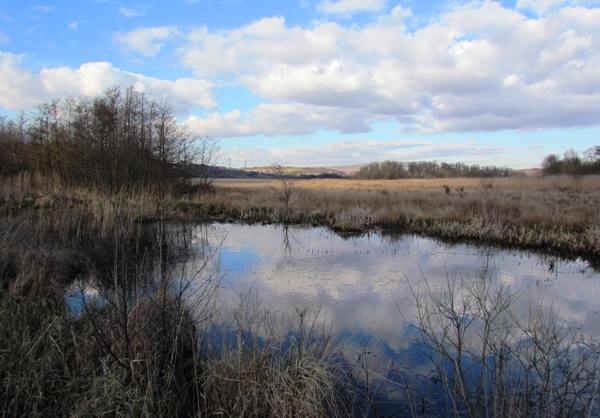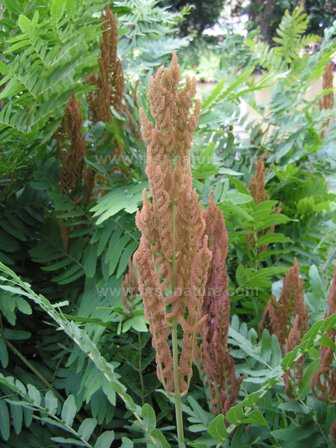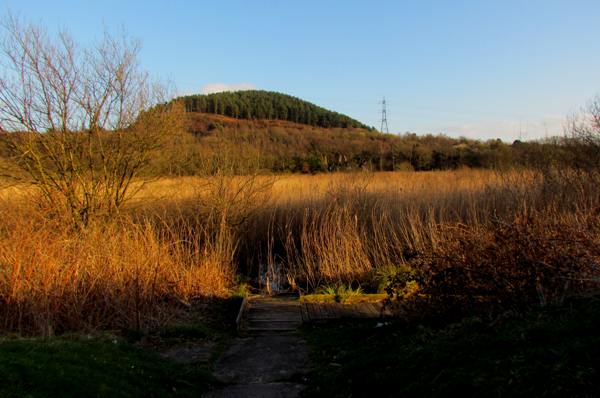Crymlyn Bog and Pant y Sais National Nature Reserve, Swansea, Wales
Designations: SSSI, RAMSAR, Cors Crymlyn SAC
Below: Crymlyn Bog seems a million miles away from the urban sprawl of Swansea

This NNR consists, in part, of the largest lowland fen in Wales, and despite its industrial and urban surroundings it is home to an amazing array of wildlife.
Crymlyn Bog and Pant y Sais NNR is managed by Natural Resources Wales (NRW).
Directions to Crymlyn Bog
Grid Ref: ST696945
Crymlyn Bog National Nature Reserve can be extremely difficult to find, and it lacks a direct access from any of the nearby main roads.

Entry to the main car park, where the Visitor Centre is located, is via an extremely narrow lane, but it's worth the effort it can take to find it!
From the M4 motorway turn off at Junction 43 and take the A483 (Fabian Way) towards the centre of Swansea. Look out for the Tir Jon Waste Tip on the right hand side of the road. Soon after passing the Tip get ready to filter right and turn right into Wern Terrace.
At the top of Wern Terrace turn right on to Dinam Road, and you will pass the rear entrance to Tir Jon Tip. Continue along this narrow road for approximately 1km (2/3 mile) and you will see the car park and entrance to Crymlyn Bog NNR on the right.
Directions to Pant y Sais
Although Pant y Sais is part of the same NNR as Crymlyn Bog it has a separate car park which is easier to find and has direct access to a boardwalk through the reserve.
From the M4 turn off at Junction 43 and take the A483 (Fabian Way) towards Swansea town centre. At the first roundabout turn on to the B4290 towards Jersey Marine. The Pant y Sais car park is directly off the B4290 once you are beyond Jersey Marine.
Access
The reserve is open all year round and there are tracks and boardwalks through the bog and its reedbeds. The boardwalk at Pant y Sais is curtailed and does not reach as far as the Tennent Canal, and so there is currently no access to that part of the NNR from the canal towpath.
Below: Royal Fern growing close to the canal at Pant y Sais

Facilities
There is a Visitor Centre at the Cymlyn Bog entrance and car park, but this is only opened to members of the public by prior arrangement. There are information boards at both parts of the reserve.
Description of Site
Despite its urban location this NNR has outstanding wildlife, and once in the nature reserve on a lovely summer day it is almost impossible to believe that the vast urban and industrial sprawl of Swansea that surrounds it is so close.
Crymlyn Bog lies in a large depression which was carved out when the glaciers retreated at the end of the last Ice Age approximately 12,000 years ago. Pant y Sais is similar but on a much smaller scale. The Lowland Fen at Crymlyn Bog has areas of Transition Mire and Quaking Bog. These habitats are becoming increasingly rare and are the reasons for the special designations conferred on this site. The term 'transition mire' refers to general ecological characteristics which are transitional between acid bog and alkaline fen, and this means that there is an unusual mix of plants growing in the area - some are acid tolerant while others would normally only be found in alkaline habitats. Some parts of this type of habitat consist of floating vegetation and are extremely unstable - so-called quaking bogs - but these occur on a relatively small scale at Crymlyn Bog, and it is a constant battle to prevent the quaking bog areas being taken over by the aggressive growth of the Common Reed (Pragmites australis).
Other factors that would negatively impact upon this very special habitat are increased nutrient enrichment levels in water running into the site and also the lack of suitable grazing, although the latter problem is solved by allowing ponies to graze the bog at appropriate times of the year.
Below: The boardwalk at Pant y Sais

The plants found at Crymlyn Bog and Pant y Sais are very interesting, and some of the most beautiful ones include Yellow Iris (Iris pseudacorus), Bogbean (Menyanthes trifoliata) which has white, frothy flowers in April and early May, Marsh Cinquefoil (Comosum palustre) which has dark reddish-brown flowers in June and Royal Fern (Osmunda regalis). Royal Fern is a deciduous plant which is sometimes known as 'the flowering fern' because it produces large reddish-brown fronds that look like flower-spikes. Although native to Europe, Africa, Asia and the Americas Royal Fern is becoming increasingly rare in Britain as a result of wetland drainage for agricultural purposes. It's 'royal' title is because it is one of the largest and most imposing ferns that grow in Europe. Other interesting plants at Crymlyn Bog include Slender Cotton-grass (Eriophorum gracile) which is nationally rare, and Lesser Water-plantain (Baldellia ranunculoides) which has pale pink flowers each with three petals.
The abundant reedbeds at Crymlyn Bog and Pant y Sais make it a great place to see and hear birds, some of which breed on the site - Reed Warblers (Acrocephalus scirpaceus), Sedge Warblers (Acrocepholus schoenobaenus), Reed Buntings (Emberiza schoeniclus), Cetti's Warbler (Cettia cetti) and Water Rails (Rallus aquaticus) among them. Other rarer visitors to the reserve are Bitterns (Botaurus stellaris), Bearded Tits (Panurus biarmicus) and Marsh Harriers (Circus aeruginosus).